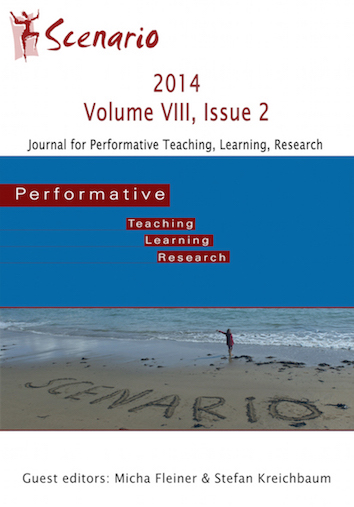Non-Verbal Communication: Why We Need It in Foreign Language Teaching and How We Can Foster It with Drama Activities
DOI:
https://doi.org/10.33178/scenario.8.2.3Abstract
Even though non-verbal communication is an essential part of communicative situations, it still is a neglected issue in foreign language teaching. This is quite surprising as no language learner can achieve communicative competence without having some knowledge of non-verbal phenomena, which make communication authentic and serve numerous functions needed for communicative success.Teaching a combination of verbal and non-verbal aspects of communication has positive effects on the language learning process in general and on the students’ willingness to communicate in particular. Furthermore, it is important for language learners to become aware of the role non-verbal communication plays in intercultural encounters. Additionally, the knowledge and awareness of the functions of non-verbal communication also help to develop literary competence since non-verbal phenomena contribute to a text’s meaning and its effect on the reader in both drama and prose.The objectives of this paper are to outline the nature and functions of non-verbal communication, to show why integrating non-verbal phenomena into different areas of FLT can be highly valuable, and to present drama activities that help sensitise students to non-verbal aspects of communication in various contexts.References
Abercrombie, David (1968): Paralanguage. In: British Journal of Disorders of Communication 3, 55-59
Argyle, Michael (1972): Non-verbal Communication in Human Social Interaction. In: Hinde, Robert A. (ed.): Non-verbal Communication. Cambridge: Cambridge UP, 243-269
Argyle, Michael (2002 [1979]): Körpersprache und Kommunikation. Das Handbuch zur nonverbalen Kommunikation. Paderborn: Junfermann
Birdwhistell, Ray L. (1955): Background to Kinesics. In: ETC 13, 10-18
Bouchara, Abdelaziz (2009): Zum Erwerb interkultureller Kompetenz am Beispiel der Proxemik. In: Zielsprache Deutsch 36/2, 3-29
Brekle, Wolfgang (1995): Didaktische Überlegungen zum darstellenden Spiel im Deutschunterricht. In: Deutschunterricht 48/3, 114-121
Burgoon, Judee K. et al. (1989): Nonverbal Communication. The Unspoken Dialogue. New York: Harper & Row
Common European Framework of Reference for Languages. Learning, Teaching, Assessment. http://www.coe.int/t/dg4/linguistic/source/framework_en.pdf (Accessed 16 January 2015)
Crystal, David (1974): Paralinguistics. In: Sebeok, Thomas A. (ed.): Current Trends in Linguistics. Vol. 12. Den Haag: Mouton, 265-295
Culham, Cameron R. (2002): Coping With Obstacles in Drama-Based ESL Teaching. A Nonverbal Approach. In: Bräuer, Gerd (ed.): Body and Language. Intercultural Learning Through Drama. London: Ablex, 95-112
Ekman, Paul; Friesen, Wallace (1969): The Repertoire of Nonverbal Behavior: Categories, Origins, Usage and Coding. In: Semiotica 1, 49-98
Elis, Franziska (2015): Mit dramapädagogischen Methoden sprachliche und kommunikative Kompetenzen fördern. In: Hallet, Wolfgang; Surkamp, Carola (eds.): Handbuch Dramendidaktik und Dramapädagogik im Fremdsprachenunterricht. Trier: WVT, 89-115.
Eßer, Ruth (2007): Körpersprache in Babylon. In: Krumm, Hans-Jürgen (ed.): Bausteine für Babylon. Sprache, Kultur, Unterricht. München: iudicum, 320-332
Gudykunst, William B.; Kim, Young Yun (1997 [1984]): Communicating with Strangers. An Approach to Intercultural Communication. Reading, MA/Menlo Park, CA: Addison-Wesley
Gullberg, Marianne; McCafferty, Steven G. (2008): Introduction to Gesture and SLA. Toward an Integrated Approach. In: Studies in Second Language Acquisition 30/2, 133-146
Hall, Edward T. (1966): The Hidden Dimension. New York: Doubleday
Hinner, Michael B. (1998): The Importance of Intercultural Communication in a Globalized World. http://ideas.repec.org/p/fth/freiba/98-6.html (Accessed 16 January 2015)
Jakobson, Roman (1960): Closing Statement. Linguistics and Poetics. In: Sebeok, Thomas A. (ed.): Style in Language. Cambridge, Mass.: MIT Press, 350-377
Kao, Shin-Mei; O’Neill, Cecily (1998): Words into Worlds. Learning a Second Language through Process Drama. Westport, CT: Ablex
Karbowska-Hayes, Suzanne (1984): Drama as a Second Language. A Practical Handbook for Language Teachers. Cambridge: National Extension College
Kendon, Adam (2004): Gesture. Visible Action as Utterance. New York: Cambridge UP
Knabe, Kristin (2007): Fremdsprachen effektiver lernen mit Gestik. Zur Theorie und Praxis von Gestik in der Fremdsprachendidaktik. Frankfurt a. M.: Lang
Korte, Barbara (1993): Körpersprache in der Literatur. Theorie und Geschichte am Beispiel englischer Erzählprosa. Tübingen: Francke
Maley, Alan; Duff, Alan (2001): Drama Techniques in Language Learning. A Resource Book of Communication Activities for Language Teachers. Cambridge: Cambridge UP
Matthias, Bettina (2007): ‘Show, don’t tell!’ Improvisational Theater and the Beginning Foreign Language Curriculum. In: Scenario 1/1, 56-69
Müller, Frank (1992): Dialog zwischen Text und Untertext. Theaterspielen als Sprechhandeln. In: Diskussion Deutsch 23/126, 365-374
Müller, Thomas (2008): Dramapädagogik und Deutsch als Fremdsprache. Eine Bestandsaufnahme. Saarbrücken: VDM
Nünning, Ansgar; Surkamp, Carola (2010): Englische Literatur unterrichten 1. Grundlagen und Methoden. 3rd ed. Seelze-Velber: Kallmeyer-Klett
Özkul, Senem (2012): Speaking foreign body language. In: Praxis Fremdsprachenunterricht Englisch 9/5, 16-17.
Poyatos, Fernando (1983): New Perspectives in Nonverbal Communication. Oxford: Pergamon
Reimann, Daniel (2000): Französisch durch Gesten. Bausteine einer Didaktik der nonverbalen Kommunikation. In: Französisch heute 1, 68-82
Reimann, Daniel (2008): Nonverbale Kommunikation im Spanischunterricht und interkulturelles Hör-/Sehverstehen. In: Hispanorama 121, 93-97
Reimann, Daniel (2012): Nonverbale Kommunikation zum Thema machen. Sprach- und kulturraumspezifische Gesten im Fremdsprachenunterricht. In: Pädagogik 64/10, 36-39
Rothwell, Julia (2011): Bodies and Language. Process Drama and Intercultural Language Learning in a Beginner Language Classroom. In: RiDE: The Journal of Applied Theatre and Performance 16/4, 575-594
Scherer, Klaus R. (1980): The Functions of Nonverbal Signs in Conversation. In: Giles, Howard; St. Clair, Roger (eds.): The Social and Psychological Contexts of Communication. Hillsdale: L. Erlbaum, 225-244
Schewe, Manfred (1993): Fremdsprache inszenieren. Zur Fundierung einer dramapädagogischen Lehr- und Lernpraxis. Oldenburg: Didaktisches Zentrum der Universität Oldenburg
Strasser, Margareta (2008): Verständigungsstrategien bei sehr geringen Sprachkenntnissen. Eine explorative Studie zur Kommunikation unter Bedingungen der Interkomprehension. Wien: Praesens
Surkamp, Carola (2012): Literarische Texte im kompetenzorientierten Fremdsprachenunterricht. In: Hallet, Wolfgang; Krämer, Ulrich (eds.): Kompetenzaufgaben im Englischunterricht. Grundlagen und Unterrichtsbeispiele. Seelze-Velber: Kallmeyer-Klett, 77-90
Tomalin, Barry; Stempleski, Susan (1993): Cultural Awareness. Oxford: Oxford UP.
Tselikas, Elektra I. (1999): Dramapädagogik im Sprachunterricht. Zürich: Orell Füssli.
Waegner, Heinrich (2003): Theaterwerkstatt. Kommentierte Wege vom Warm-up bis zur Spielvorlage. Stuttgart: Klett
Zephaniah, Benjamin (1999): Face. London: Bloomsbury.
Published
Issue
Section
License
Copyright (c) 2014 the author(s)

This work is licensed under a Creative Commons Attribution-NonCommercial-NoDerivatives 4.0 International License.







